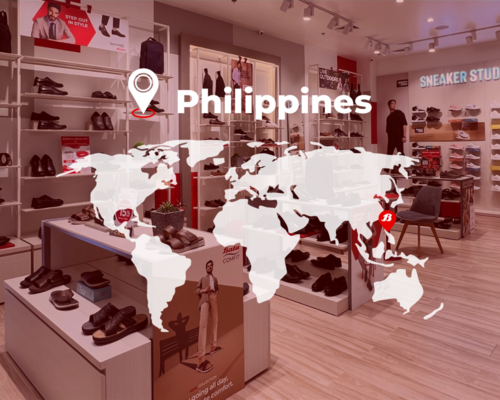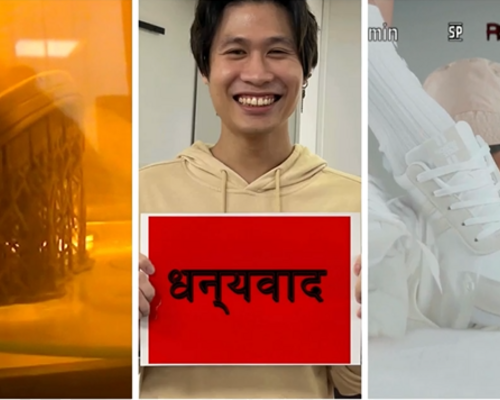Ask a Bata Expert: Answering Your Burning Shoe Questions

Do you have a question about shoes? We asked our social media followers from around the world what they wanted to know about shoes and now it’s time for our experts to answer. The most common questions showed us that no matter the country, customs, or climate, everyone seems to share similar struggles. We love sharing knowledge and had a blast digging into the topics that came up most frequently. Get ready to become a lot wiser about footwear!
How do you stretch tight shoes?
Realising that your new shoes are just a bit too tight can be a let-down and might make you never want to wear them again. Thankfully, there are ways to safely stretch your shoes no matter the material – leather, textile, or synthetic.
Stretching leather shoes
If your shoes are only slightly too tight and they’re made out of leather, wear them every night when you get home from work. They should stretch out naturally in about a week. If that doesn’t work, you can put on a pair of thick socks, put your shoes on, take a hair dryer and blow hot air on the tight areas for 20-30 seconds. Don’t hesitate to repeat this step a few times but make sure you let the shoes cool down between heating sessions. When you’re happy with the result, apply leather conditioner to restore any lost moisture and prevent damage to your shoes.
You can also use devices called shoe stretchers to loosen up leather dress shoes. Wedge them down into your shoes and set the amount of tension with the attached hand crank to get as much or as little stretch you need. They also come with customisable add-ons, so you can target specific pain points in your shoe that need the most work. Test if your shoes are stretched after about 24 hours and always remember to not push the leather too hard – nobody wants their beautiful leather to crack. Alternatively, you can also invest in a shoe stretcher spray. All you need to do is apply the spray to both the inside and outside of the spots that need stretching and then put your shoes on. The spray softens and loosens the leather which helps it adjust to the shape of your foot.
Textile and synthetic shoes
There’s a different method for shoes made from materials such as textile, canvas, or synthetics. You start by filling a Ziploc bag with water, insert it into your shoe and let it freeze overnight. As the water turns into ice, it expands and forces your shoe to stretch out evenly. In the morning, take your shoe out of the freezer and let it thaw for about 20-30 minutes. Remove the Ziploc bag and voilà, you have a perfectly fitting shoe.
How do you clean shoes properly?
When it comes to cleaning, there seems to be two different types of shoes that give people the most trouble – leather shoes and white sneakers. Here’s some shoe cleaning ideas for both of these.
Leather shoe care
When it comes to leather shoes, you should always think of cleaning as a three-step process. Begin by getting rid of dirt using a gentle brush or mildly damp cloth, and if needed, follow up with a specialised leather cleaner to remove any remaining stubborn spots. In the second step, you’ll want to revitalise the leather by applying an all-purpose conditioning cream to cover up small scratches and scuffs. This also helps prolong your shoes’ life.
In the third and final step, apply a thin layer of neutral shoe wax to get your shoes back to looking their best. Allow your shoes to air dry away from direct sunlight and there you have it: a clean and shining pair of your favourite shoes ready to go.
Dealing with white sneakers
The one place dirt really stands out is on those beaming white sneakers. For some, this can be reason enough to never wear them. For others, it’s a source of endless headaches. It doesn’t have to be this way when you have the right shoe cleaning kit. All it takes is to use cleaning wipes on the smooth surfaces and sneaker shampoo on the textile parts. They are easy to use, don’t require any clean-up after and leave your shoes with a pleasant scent. In case you don’t have these cleaning solutions, here are a few DIY shoe cleaning tips.
Let’s start with baking soda and vinegar. When you combine a tablespoon of each with a tablespoon of hot water, you get an effective cleaning paste. Rub this paste all over your dirty shoes in a circular motion and then let them dry somewhere warm for a few hours. Simply remove the dried paste by clapping the shoes together and you’re done. If you don’t have baking soda and vinegar, you can apply regular toothpaste to your shoes and follow the same process.
Bleach is another option for a specialised shoe cleaning solution (if you can handle the odour, that is). It’s very easy to use. Just add a couple of drops to hot water and apply the solution all over your shoes with a toothbrush. To avoid the smell of bleach lingering on your shoes, rinse the mixture off with a damp cloth before setting your shoes aside to dry.
What is my shoe size using international measuring conventions?
International shoe sizes can get complicated. As if it’s not hard enough to deal with differences between the metric system and the imperial system, there are different shoe size conventions to contend with too. The oldest one, the imperial system, was first established in Britain in the 14th century and involves the barleycorn. Barleycorns are roughly 1/3 of an inch long (around 8.47mm) and they still impact shoe size measurements in both the US and UK today. Shoe size in continental Europe is measured using Paris points, a unit invented by French shoemakers in the early 1800s. Paris points are in increments of 2/3 of a centimetre (or 6.67mm).
The good news is you don’t have to do any shoe size conversion maths today. To make sure you get the right shoe size, measure your feet and use the shoe size chart below to easily translate your size internationally.
Women's Shoe Size Conversion
| Unit | Size | ||||||||||||||||
|---|---|---|---|---|---|---|---|---|---|---|---|---|---|---|---|---|---|
| US & CAN | 4 | 4.5 | 5 | 5.5 | 6 | 6.5 | 7 | 7.5 | 8 | 8.5 | 9 | 9.5 | 10 | 10.5 | 11 | 11.5 | 12 |
| UK | 2 | 2.5 | 3 | 3.5 | 4 | 4.5 | 5 | 5.5 | 6 | 6.5 | 7 | 7.5 | 8 | 8.5 | 9 | 9.5 | 10 |
| EU | 35 | 35 | 35-36 | 36 | 36-37 | 37 | 37-38 | 38 | 38-39 | 39 | 39-40 | 40 | 40-41 | 41 | 41-42 | 42 | 42-43 |
| Inch | 8.2 | 8.3 | 8.5 | 8.8 | 8.9 | 9.1 | 9.3 | 9.4 | 9.5 | 9.7 | 9.9 | 10 | 10.2 | 10.3 | 10.5 | 10.7 | 10.9 |
| Cm | 20.8 | 21.3 | 21.6 | 22.2 | 22.5 | 23 | 23.5 | 23.8 | 24.1 | 24.6 | 25.1 | 25.4 | 25.9 | 26.2 | 26.7 | 27.1 | 27.6 |
Men's Shoe Size Conversion
| Unit | Size | ||||||||||||||||
|---|---|---|---|---|---|---|---|---|---|---|---|---|---|---|---|---|---|
| US & CAN | 6 | 6.5 | 7 | 7.5 | 8 | 8.5 | 9 | 9.5 | 10 | 10.5 | 11 | 11.5 | 12 | 13 | 14 | 15 | 16 |
| UK | 5.5 | 6 | 6.5 | 7 | 7.5 | 8 | 8.5 | 9 | 9.5 | 10 | 10.5 | 11 | 11.5 | 12.5 | 13.5 | 14.5 | 15.5 |
| EU | 39 | 39 | 40 | 40-41 | 41 | 41-42 | 42 | 42-43 | 43 | 43-44 | 44 | 44-45 | 45 | 46 | 47 | 48 | 49 |
| Inch | 9.3 | 9.5 | 9.6 | 9.8 | 99 | 10.1 | 10.3 | 10.1 | 10.6 | 10.8 | 10.9 | 11.1 | 11.3 | 11.6 | 11.9 | 12.2 | 12.5 |
| Cm | 2.35 | 24.1 | 24.4 | 24.8 | 25.4 | 25.7 | 26 | 26.7 | 27 | 27.3 | 27.9 | 28.3 | 28.6 | 29.4 | 30.2 | 31 | 31.8 |
How do I know if the shoe fits correctly?
Stepping into a shoe store and finding a pair with the right length is easy enough, but there’s more to it if you want a fit that will deliver both comfort and health to your feet. For that, you should consider the width of your foot and the height of your arch.
If you have narrow feet, you may find yourself sliding around in your shoes even though they are the right length. It’s important to choose from naturally narrow shoe styles or shoes designed for narrow feet. If you already have a pair of shoes that feel too wide, try adding an insole or wearing thicker socks to keep your feet in place. For those of you with wider feet, look for shoes that have flexible elements such as laces or straps to accommodate your unique foot shape.
Having flat feet is a very common foot condition that requires extra consideration when shopping for shoes. You will benefit from heavier, less flexible shoes that provide more support for your arch. This will help take pressure off the centre of your foot and allow for good alignment. People who struggle with the opposite, a high arch, will benefit from selecting shoes with a supportive midsole and soft insole. It also helps to have a shoe that’s snug around the ankle to prevent excessive twisting injuries.
Whether you care about shoe fashion or not, choosing the right Bata shoes for your foot shape will assure both comfort and style.
What should I do if I get blisters after wearing a shoe for the first time?
Unfortunately, the main cause of blisters are improperly fitting shoes rubbing against your skin. This is why it’s so important to carefully choose the right size and type of shoe. However, if you feel a dreaded blister forming while wearing your brand new shoes for the first time, don’t worry. There are a few things you can do. When it comes to your shoes, you can try stretching them a bit using the advice in this article. Breaking a shoe in often helps solve this issue. Another thing you should do is protect your skin against direct contact with the shoe. Wearing socks, using special anti-blister sticks, and even placing band-aids on the spots most at risk, can go a long way in preventing blisters
As for your feet? Please try to resist the urge to pop the blister! If you leave it intact, there won’t be any increased risk of infection and your skin will recover faster. If the blister does open up, clean it gently with mild soapy water and then cover with a plaster. Keep the foot clean and dry while it heals and avoid wearing anything that irritates the affected area.


